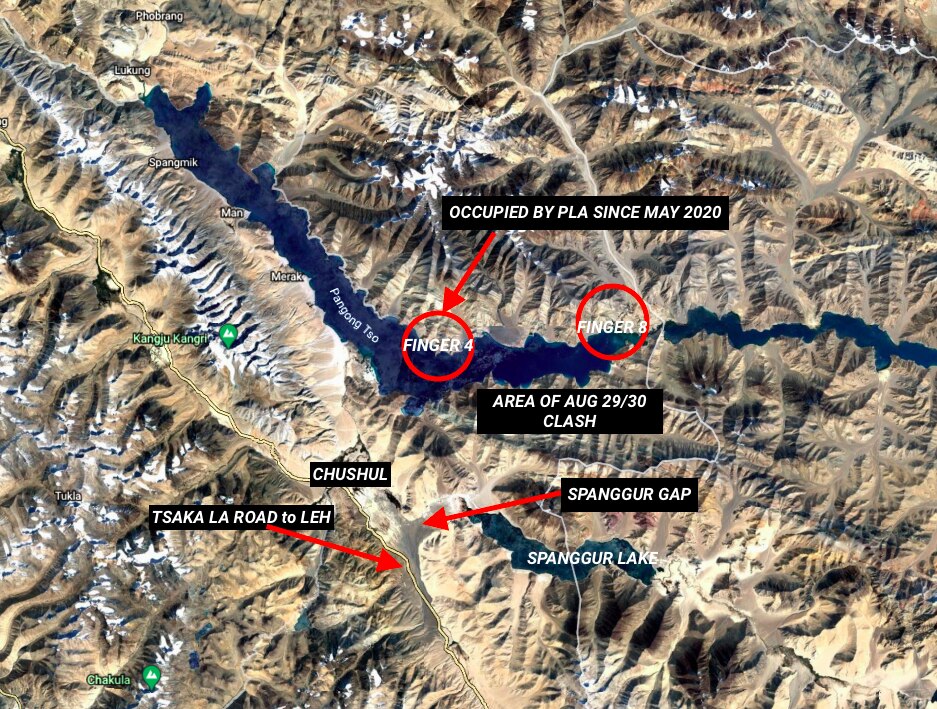
SOURCE: INDIA TODAY
Among the many military options available with the Indian Army in its impasse with China is the ‘Quid Pro Quo’, or simply QPQ. This involves the army responding to a PLA intrusion across the Line of Actual Control (LAC) by moving into a sector and occupying territory on the Chinese side. In fact, the ‘QPQ’ was being debated by Indian military strategists in the past few days as a possible option/ bargaining chip to force the PLA to withdraw. Was the option exercised over the weekend?
On Monday morning, the army put out an official statement stating that it had ‘thwarted Chinese intentions to alter the ground situation’. Hours later, a statement from the PLA’s Western Theatre Command accused ‘Indian troops on Monday of illegally crossing the LoC again (India calls it the LAC)’ at the southern bank of the Pangong Tso lake and near the Reqin Mountain and ‘conducting flagrant violations’.
An editorial in the Chinese Communist Party mouthpiece, Global Times, said the south bank of the lake, where the confrontation took place, is under China’s control and accused India of ‘trying to turn it into a new disputed area as a bargaining chip in negotiations’. A statement from the Chengdu-based Western Theatre Command spokesperson Senior Colonel Zhang Shuili, urged the Indian side to ‘immediately withdraw its troops and avoid any escalation in the situation’.
It is not known if the clashes resulted in any casualties, but these statements assume significance in the light of Chief of Defence Staff Gen. Bipin Rawat’s August 24 statement. Gen. Rawat had said that “the military option to deal with the Chinese army’s transgressions was there, but would be exercised only if talks at the military and diplomatic level fail”.
In May this year, the PLA transgressed the LAC in at least five places in eastern Ladakh. Over a dozen rounds of talks have failed to break the deadlock. The PLA has so far refused to move back from the Finger 4 area it occupies on the Pangong lake, well behind the Finger 8 area India considers to be the LAC.
Monday’s statement by Army spokesperson Col. Aman Anand said that on the night of August 29/30, PLA troops violated the previous consensus arrived at during military and diplomatic engagements in the ongoing standoff in eastern Ladakh and carried out provocative military movements to change the status quo. “Indian troops pre-empted this PLA activity on the southern bank of the Pangong Tso lake, and undertook measures to strengthen our positions and thwart Chinese intentions to unilaterally change facts on the ground,” Col. Anand said. The Indian Army is committed to maintaining peace and tranquility through dialogue but is equally determined to protect its territorial integrity. A brigade commander level flag meeting is in progress at Chushul to resolve the issue, the statement added.
Social media posts on Twitter seemed to indicate the involvement of a covert Indian paramilitary unit, the Special Frontier Force (SFF), in the operation south of Pangong Tso. The SFF operates under the Directorate General of Security (DGS), a wing of India’s external intelligence agency R&AW. The DGS, in fact, predates it and was set up in 1962 after the India-China border war. The unit, also known as Establishment 22 and ‘Vikas’ is officered by the Indian army and recruits its personnel from among the Tibetan diaspora settled in India. Its personnel has participated in India’s various wars, from 1971 to the 1999 Kargil War.






